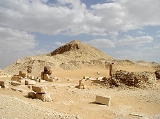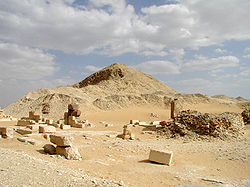
23rd century BC
Encyclopedia
The 23rd century BC is a century
which lasted from the year 2300 BC to 2201 BC.

Century
A century is one hundred consecutive years. Centuries are numbered ordinally in English and many other languages .-Start and end in the Gregorian Calendar:...
which lasted from the year 2300 BC to 2201 BC.
Events

- 2334 BC24th century BCThe 24th century BC is a century which lasted from the year 2400 BC to 2301 BC.-Events:*c. 2900 BC – 2334 BC: Mesopotamian wars of the Early Dynastic period continue.*c. 2360 BC: Hekla-4 eruption....
– 2279 BC: (short chronology) Sargon of AkkadSargon of AkkadSargon of Akkad, also known as Sargon the Great "the Great King" , was an Akkadian emperor famous for his conquest of the Sumerian city-states in the 23rd and 22nd centuries BC. The founder of the Dynasty of Akkad, Sargon reigned in the last quarter of the third millennium BC...
's conquest of MesopotamiaMesopotamiaMesopotamia is a toponym for the area of the Tigris–Euphrates river system, largely corresponding to modern-day Iraq, northeastern Syria, southeastern Turkey and southwestern Iran.Widely considered to be the cradle of civilization, Bronze Age Mesopotamia included Sumer and the...
. - 2333 BC: Beginning of the GojoseonGojoseonGojoseon was an ancient Korean kingdom. Go , meaning "ancient," distinguishes it from the later Joseon Dynasty; Joseon, as it is called in contemporaneous writings, is also romanized as Chosŏn....
, the first dynasty and government system in KoreaKoreaKorea ) is an East Asian geographic region that is currently divided into two separate sovereign states — North Korea and South Korea. Located on the Korean Peninsula, Korea is bordered by the People's Republic of China to the northwest, Russia to the northeast, and is separated from Japan to the...
. - c. 2300 BC: Bronze AgeBronze AgeThe Bronze Age is a period characterized by the use of copper and its alloy bronze as the chief hard materials in the manufacture of some implements and weapons. Chronologically, it stands between the Stone Age and Iron Age...
starts. - c. 2300 BC – 2184 BC: Disk of EnheduannaEnheduannaEnheduanna , also transliterated as Enheduana, En-hedu-ana or EnHeduAnna , was an Akkadian princess as well as High Priestess of the Moon god Nanna in the Sumerian city-state of Ur...
, from UrUrUr was an important city-state in ancient Sumer located at the site of modern Tell el-Muqayyar in Iraq's Dhi Qar Governorate...
, (modern Muqaiyir, IraqIraqIraq ; officially the Republic of Iraq is a country in Western Asia spanning most of the northwestern end of the Zagros mountain range, the eastern part of the Syrian Desert and the northern part of the Arabian Desert....
) is made. It is now in University of Pennsylvania Museum of Archaeology and AnthropologyUniversity of Pennsylvania Museum of Archaeology and AnthropologyThe University of Pennsylvania Museum of Archaeology and Anthropology, commonly called The Penn Museum, is an archaeology and anthropology museum that is part of the University of Pennsylvania in the University City neighborhood of Philadelphia, Pennsylvania.-History:An internationally renowned...
, University of PennsylvaniaUniversity of PennsylvaniaThe University of Pennsylvania is a private, Ivy League university located in Philadelphia, Pennsylvania, United States. Penn is the fourth-oldest institution of higher education in the United States,Penn is the fourth-oldest using the founding dates claimed by each institution...
, Philadelphia. - c. 2300 BC – 2200 BC: Head of a man from NinevehNinevehNineveh was an ancient Assyrian city on the eastern bank of the Tigris River, and capital of the Neo Assyrian Empire. Its ruins are across the river from the modern-day major city of Mosul, in the Ninawa Governorate of Iraq....
(modern Kuyunjik, IraqIraqIraq ; officially the Republic of Iraq is a country in Western Asia spanning most of the northwestern end of the Zagros mountain range, the eastern part of the Syrian Desert and the northern part of the Arabian Desert....
) is made. It is now in Iraq Museum, BaghdadBaghdadBaghdad is the capital of Iraq, as well as the coterminous Baghdad Governorate. The population of Baghdad in 2011 is approximately 7,216,040...
. - c. 2300 BC: Canal Bahr Yusuf (current name) is created when the waterway from the NileNileThe Nile is a major north-flowing river in North Africa, generally regarded as the longest river in the world. It is long. It runs through the ten countries of Sudan, South Sudan, Burundi, Rwanda, Democratic Republic of the Congo, Tanzania, Kenya, Ethiopia, Uganda and Egypt.The Nile has two major...
to the natural lake (now Lake MoerisLake MoerisLake Moeris is an ancient lake in the northwest of the Faiyum Oasis, southwest of Cairo, Egypt. It persists in modern times as a smaller lake called Birket Qarun. The lake's surface is 140 ft below sea-level, and covers about ....
) is widened and deepened to create a canal. - c. 2288 BC – 2224/2194 BC: Pepy II and his mother, Queen Merye-ankhnes, Sixth dynasty of EgyptSixth dynasty of EgyptThe sixth dynasty of ancient Egypt is often combined with Dynasties III, IV and V under the group title the Old Kingdom.-Pharaohs:...
, is made. It is now at The Brooklyn Museum of Art, New YorkNew YorkNew York is a state in the Northeastern region of the United States. It is the nation's third most populous state. New York is bordered by New Jersey and Pennsylvania to the south, and by Connecticut, Massachusetts and Vermont to the east...
. - c. 2285 BC: EnheduannaEnheduannaEnheduanna , also transliterated as Enheduana, En-hedu-ana or EnHeduAnna , was an Akkadian princess as well as High Priestess of the Moon god Nanna in the Sumerian city-state of Ur...
, high priestess of the moon god NannaNanna-Mythology:* Nanna or Sin , god of the moon in Sumerian mythology, also called Suen* Nanna , goddess and wife of the god Baldr in Norse mythology-People:* Nanna , a Scandinavian female name...
in UrUrUr was an important city-state in ancient Sumer located at the site of modern Tell el-Muqayyar in Iraq's Dhi Qar Governorate...
, was born. - c. 2278 BC: PharaohPharaohPharaoh is a title used in many modern discussions of the ancient Egyptian rulers of all periods. The title originates in the term "pr-aa" which means "great house" and describes the royal palace...
Pepi II starts to rule (other date is 2383 BC). - c. 2254 BC – 2218 BC: Stela of Naram-SinNaram-SinNaram-Sin , reigned ca. 2254–2218 BCE, short chronology, was the third successor and grandson of King Sargon of Akkad. Under Naram-Sin the Akkadian Empire reached its zenith...
, probably from SipparSipparSippar was an ancient Near Eastern city on the east bank of the Euphrates river, located at the site of modern Tell Abu Habbah in Iraq's Babil Governorate, some 60 km north of Babylon and 30 km southeast of Baghdad....
, discovered in SusaSusaSusa was an ancient city of the Elamite, Persian and Parthian empires of Iran. It is located in the lower Zagros Mountains about east of the Tigris River, between the Karkheh and Dez Rivers....
(modern ShushShushShush may be:*the Iranian town of Shush**the Persian name of ancient Susa, which is next to the modern town**Shush County, Iran**a Tehran metro station* S.H.U.S.H., the fictional peace-keeping organization* Slang to keep quiet...
, IranIranIran , officially the Islamic Republic of Iran , is a country in Southern and Western Asia. The name "Iran" has been in use natively since the Sassanian era and came into use internationally in 1935, before which the country was known to the Western world as Persia...
), is made. It is now in Musée du Louvre, ParisParisParis is the capital and largest city in France, situated on the river Seine, in northern France, at the heart of the Île-de-France region...
. - c. 2240 BC: AkkadAkkadThe Akkadian Empire was an empire centered in the city of Akkad and its surrounding region in Mesopotamia....
, capital of the Akkadian Empire, becomes the largest city in the world, surpassing MemphisMemphis, EgyptMemphis was the ancient capital of Aneb-Hetch, the first nome of Lower Egypt. Its ruins are located near the town of Helwan, south of Cairo.According to legend related by Manetho, the city was founded by the pharaoh Menes around 3000 BC. Capital of Egypt during the Old Kingdom, it remained an...
, capital of EgyptAncient EgyptAncient Egypt was an ancient civilization of Northeastern Africa, concentrated along the lower reaches of the Nile River in what is now the modern country of Egypt. Egyptian civilization coalesced around 3150 BC with the political unification of Upper and Lower Egypt under the first pharaoh...
. - c. 2220 BC Scord of BrousterScord of BrousterThe Scord of Brouster is one of the earliest Neolithic farm sites in Shetland, Scotland. It has been dated to 2220 BC with a time window of 80 years on either side. It comprises three houses, several fields surrounded by walls, and a cairn...
farmstead established in Shetland, Scotland - c. 2215 BC: Comet Hale-BoppComet Hale-BoppComet Hale–Bopp was perhaps the most widely observed comet of the 20th century, and one of the brightest seen for many decades...
appeared. A GutiGuti (Mesopotamia)The Gutian dynasty came to power in Mesopotamia around 2150 BC , by destabilising Akkad, according to the Sumerian kinglist at the end of the reign of king Ur-Utu of Uruk. They reigned for perhaps around one century...
army swept down from the Zagros MountainsZagros MountainsThe Zagros Mountains are the largest mountain range in Iran and Iraq. With a total length of 1,500 km , from northwestern Iran, and roughly correlating with Iran's western border, the Zagros range spans the whole length of the western and southwestern Iranian plateau and ends at the Strait of...
and defeated the demoralized Akkadian army. They took Agade, the capital of AkkadAkkadThe Akkadian Empire was an empire centered in the city of Akkad and its surrounding region in Mesopotamia....
, and destroyed it thoroughly. - c. 2300 BC: Metals started to be used in Northern EuropeNorthern EuropeNorthern Europe is the northern part or region of Europe. Northern Europe typically refers to the seven countries in the northern part of the European subcontinent which includes Denmark, Estonia, Latvia, Lithuania, Norway, Finland and Sweden...
.
Significant persons
- Sargon of AkkadSargon of AkkadSargon of Akkad, also known as Sargon the Great "the Great King" , was an Akkadian emperor famous for his conquest of the Sumerian city-states in the 23rd and 22nd centuries BC. The founder of the Dynasty of Akkad, Sargon reigned in the last quarter of the third millennium BC...
, founder of the Akkadian Empire and the earliest empire builder in recorded history - 2279 BC—Death of Sargon ISargon ISargon I or Sharru-ken reigned as king of the old-Assyrian Kingdom from ca. 1920 BC to 1881 BC. The name 'Sargon' means 'the king is legitimate' in Akkadian. He is known for his work refortifying Assur. The name "Sargon I" has also been used to refer to Sargon of Akkad, and the Assyrian Sargon...

